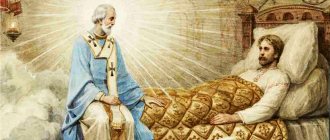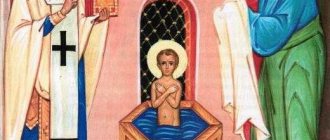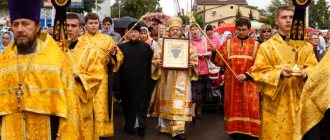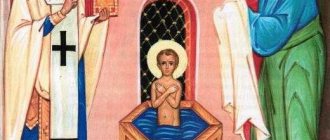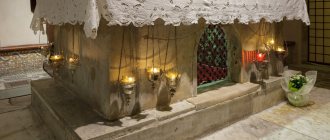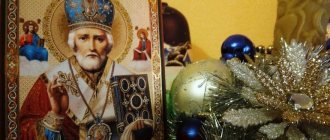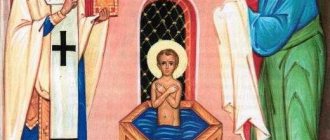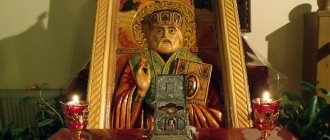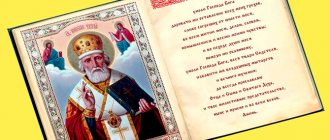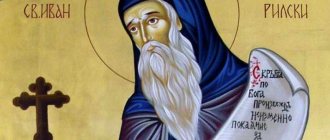Saint Nicholas the Wonderworker is one of the most revered men and servants of the Lord. He is also called Nicholas the Pleasant or Nicholas of Myra (St. Nicholas). People turn to the saint with a variety of problems - they offer prayers to him to get pregnant, get married, and improve their destiny. Of course, you can pray to him about your health, family and mental anguish.
Life of Nicholas the Wonderworker
The icon of St. Nicholas the Wonderworker is a sacred image of one of the most revered Orthodox saints. Nicholas the Wonderworker was born in the 3rd century into a Christian family in the city of Patara (modern Turkey). From a young age he studied the Holy Scriptures. Upon reaching the required age, he was ordained a priest. Later, in the city of Myra, Lycian region, Nicholas was elevated to the rank of bishop. After the death of his parents, Nikolai distributed his inheritance to everyone in need.
In 325, Nicholas the Wonderworker participated in the First Ecumenical Council, where he spoke out against the Arian heresy. After many labors, the saint peacefully departed to the Lord around 345.
Orthodox icon of St. Nicholas the Wonderworker (XVI century)
Buy an icon of the Savior
In the Radonezh icon painting workshop you can buy the most common icons of the Savior; we can provide you with most of the most popular images on the day of the “bell”. As stated above, the iconography of the Lord Jesus Christ is extensive and varied, for this reason not all icons may be available in the workshop, but if you did not find the icon you need on the pages of the site, we will paint any icons of the Savior, within the canon of the Orthodox Church, to order. Dear brothers and sisters, we wish you to find an icon of Jesus Christ, which will take its rightful place in the home and hearts of all your household members.
Special veneration of St. Nicholas the Wonderworker in Rus'
In Rus', Saint Nicholas was especially revered almost immediately from the moment of the adoption of Christianity. Thus, in the Kiev St. Sophia Cathedral, built in the mid-11th century, there is a mosaic image of St. Nicholas the Wonderworker. The first documented miracle associated with the help of St. Nicholas dates back to this same time. On the day of remembrance of the holy princes Boris and Gleb (July 24, old style), a family sailed in a boat along the Dnieper. The child fell out of the boat and drowned. That same night, in the St. Sophia Cathedral, in front of the image of St. Nicholas the Wonderworker, the child was found alive. He was all wet, as if he had just been taken out of the water.
The number of painted icons of St. Nicholas ranks second after the Mother of God images. Until the 20th century, the name Nikolai was considered the most common in Rus'.
From the life story of the Healer
The life story of the great Healer begins in the ancient town of Asia Minor, called Nicomedia. There the son of a pagan, Pantoleon, was born and raised. The young man’s mother was a Christian and instilled in her child love and faith in God, but she died very early. In his teenage years, his father sent him to a pagan school, and then under the guardianship of the then famous doctor Euphrosynus to become familiar with medicine.
The young man was talented and, with the help of faith in Jesus Christ, received from the martyr Ermolai, he healed the seriously ill
Through prayer, he helped the child, curing him of poison and returning him to the world of the living. After this incident, he was baptized and received a new name - Panteleimon.
The story about the young man’s abilities spread throughout the area, many doctors lost their profits, so one day a rumor reached Emperor Maximian himself that the Healer was visiting imprisoned Christians and treating them in God’s name. This angered the ruler, and he decided to conduct a test between Panteleimon and the pagan doctors. Thanks to faith and true petition, Panteleimon healed the patient. Many people, having seen this miracle, converted to Christianity, and the Healer paid for the victory with torment. They threw him into the sea, hung him, drowned him, wheeled him on the wheel, burned him, but the saint remained unharmed. Then in 305 the emperor ordered his head to be cut off. The great doctor prayed and then a voice called him, opening the way to the Heavenly Kingdom. After death, they wanted to burn the Healer’s body, but this attempt was unsuccessful. He was buried by grateful Christians, and the saint's head was transferred to a monastery on Mount Athos.
Icon of St. Nicholas the Wonderworker: features of writing
According to the Byzantine icon painting tradition, Saint Nicholas is most often depicted from the waist up. He appears in the form of an old man with the Gospel in his hands. Icons of this type have been known in Rus' since the 12th century. Saint Nicholas can be depicted with or without a miter (the headdress of a bishop). Also known are shoulder-length (images of only the head, up to the shoulders) variants of the image.
Also, in the upper part of the icons of St. Nicholas the Pleasant, Jesus Christ and the Mother of God are sometimes depicted. This is due to the participation of Saint Nicholas in the First Ecumenical Council (Nicaea, 325), where during an argument the saint struck the heretic Arius on the cheek. As punishment, he was removed from the rank of archpastor and put in prison. However, some participants in the Council saw the Lord Jesus and His Mother appear in a dream. They handed St. Nicholas the Gospel and the omophorion. After this, the saint was returned to the rank of bishop.
In the 13th century, a new iconographic image of St. Nicholas appeared - in full growth in hierarchal vestments (in a phelonion with an omophorion). His right hand is in a blessing gesture, and in his left he holds the Gospel. Icons of this type of writing were most widespread in Rus'; in Byzantium they are little known. An example of such an image is the Zaraisk icon, brought to the city of Zaraisk (now Moscow region) from Korsun (Crimea) in 1225.
Since the 14th century, the so-called hagiographic icons of the saint have become widespread. Along the edges of the main image there are small stamps depicting scenes from the life of the saint and his miraculous help. The most famous are such icons from Pskov and Novgorod letters.
Further development of Novgorod painting
The Novgorod school of painting of the 15th century is most richly represented. At this time, pictorial creativity enjoyed nationwide popularity in Veliky Novgorod. The picturesque icon was distinguished by imagery, dynamism, and an epic-fairytale mood. It had not only a religious, but also a decorative purpose. In addition, Novgorod creativity of this period was distinguished by its bright originality; it was created without the participation of foreign masters.
St. George. Russian Museum The image of St. George on a horse, piercing a serpent with a spear, is not only a memory of the posthumous miracle performed by St. George, but also a symbol of the main miracle in the life of a Christian - victory over passions and unbelief. “The Miracle of the Serpent” is one of the most famous miracles revealed by Saint George after his death. A huge snake resembling a dragon settled in a lake near one city. He devoured people and sheep and poisoned the air with his poisonous breath. The ruler of the city, whose inhabitants were pagans, turned to the gods, and they advised him to sacrifice a young man or girl to a snake every day. When it was the turn of the ruler’s only daughter, the girl was taken to the lake and left on the shore. She expected death with horror, but a rider appeared on a white horse. Having learned about the monster, the warrior rushed at the snake that crawled out of the lake. He pressed the monster's throat to the ground with a spear, and the horse began to trample it with its hooves. Then the warrior ordered the girl to put a belt on the pacified snake and take him to the city. Seeing the monster that she led like a quiet dog, the townspeople froze in amazement. Saint George explained to them that he had overcome the serpent by the power of Christ. When, at the request of the townspeople, the saint killed the snake, they accepted Baptism. On the spot where the snake was killed, a church was built in the name of the great martyr, near which a healing spring flowed.
Among the Novgorod icon painting compositions, “The Battle of Suzdal with the Novgorodians” is interesting as the earliest pictorial work on a historical theme: the siege of Novgorod by an army led by the Suzdal prince Mstislav Andreevich. In 1169, the Suzdal army was defeated near Novgorod. Legend says that the Novgorodians brought an icon of the Mother of God to the fortress walls. Suzdal residents shot at the icon. Then the Mother of God turned her face to the city - and the Suzdal residents were struck by blindness. They were captured or killed. Why did this legend become popular in Novgorod only in the 15th century? At this time, Moscow’s movement for Novgorod’s entry into the Moscow State had just begun, and the Suzdal residents, apparently, were identified with the Muscovites. The image is three-tiered: the upper part shows the ceremonial transfer of the icon from the Church of the Savior on Ilyin to Detinets. In the middle part, envoys from both sides travel towards each other. Below, the Novgorod cavalry rushes towards the enemy, and the Suzdal residents are depicted in confusion.
Nativity. Novgorod school. First half of the 15th century State Tretyakov Gallery (Moscow) This is one of the most remarkable icons painted on this topic. Individual scenes of the icon are depicted on slides of varying heights. The Virgin Mary is in the center of the composition. In a manger, at the entrance to a dark cave, the baby Christ lies swaddled, and a horse and an ox bow their heads over him. Above and below are angels, wise men, a shepherd, Joseph and again little Christ, whom two maids are about to immerse in the font. Gospel events are depicted here outside of space and time.
Last Judgment. Mid-15th century Novgorod school. State Tretyakov Gallery (Moscow) Even in this icon, the frightening plot is not in the foreground. First of all, attention is drawn to the radiance of colors, a certain fairy-tale chant, and the entertaining nature of individual episodes. Although in general the icon depicts pictures of the end of the world, the final judgment of all humanity, the resurrection of the dead, scenes of the hellish torment of unrepentant sinners and the heavenly bliss of the righteous. The iconography of the Last Judgment has existed in Byzantine art since the 11th-12th centuries. But these stories were created not to intimidate a person, but to make him think about his sins; “not to despair, not to lose hope, but to begin repentance” - this is precisely the message that is present in this Novgorod icon. In essence, the history of Novgorod art and its highest achievements ends with the 15th century. Moscow triumphed over feudal fragmentation, and primacy in ancient Russian artistic creativity passed to it.
- < Back
- Forward >
The image of St. Nicholas in Rus'
At the turn of the 13th-14th centuries, during the invasion of the Tatar-Mongol army on the city of Mozhaisk (modern Moscow region), a miraculous phenomenon occurred. Saint Nicholas appeared in the sky, holding a sword in his right hand and an image of the city in his left. Fear fell on the enemies and they fled in horror. This miracle formed the basis for a new type of painting of the image of the holy saint.
Also, a full-length wooden sculpture of St. Nicholas the Wonderworker has been known since the 15th century. In his right hand he has a sword, and in his left hand is a model of the city of Mozhaisk with a temple (the author of the sculpture is unknown). Currently, this sculpture is in the Moscow Tretyakov Gallery.
The flourishing of Novgorod icon painting
Details Category: Art of Ancient Russia Published 01/05/2018 17:49
At the end of the 12th century. Novgorod icon painting began to develop its own artistic style. Painting gradually moves away from Byzantine and Kyiv traditions and enhances expressiveness and emotional impact through the use of sharp white highlights. To visualize the evolution of the formation of the approach of Novgorod art to the Russian folk worldview, let us turn to the chapter from L. Lyubimov’s book “The Art of Ancient Rus'”, in which he compares two Novgorod icons of St. Nicholas: one was written at the beginning of the 13th century, and the other at the end.
Miracles from the icon of St. Nicholas the Wonderworker
In May 2013, the miraculous icon of St. Nicholas the Wonderworker was brought to Kyiv (Ukraine) from Munich (Germany) for the worship of believers. Previously, the icon belonged to the Venerable Martyr Elizabeth Feodorovna (1864-1918). Through this image, many who with faith turned to the Pleasant of God for help received healing. The brought icon was met by the rector of the church in the name of St. Michael at the Central Clinical Hospital, priest Roman Baranovsky. At that time, he had an exacerbation of chronic sinusitis, and he did not take the medicine with him. When he entered the chapel where the icon was located, he felt that the swelling had gone away on its own. From that time on, sinusitis no longer bothered him.
The icon of St. Nicholas the Wonderworker, brought from Munich, was in Kyiv for several days. At that time, sister of mercy Tatyana was in the intensive care unit of the Aleksandrovskaya Hospital. Her friends attached a small icon of the saint to the miraculous image and placed the patient under the pillow. She soon emerged from the coma and began to recover.
How does the icon of St. Panteleimon help?
First of all, the icon of St. Panteleimon the Healer helps the sick and people suffering from troubles, as it patronizes not only doctors, but also the sick, sailors, who are also often susceptible to illness and bad weather - storms, and the military.
The icon of Panteleimon protects health and a healthy spirit, gives strength, helps with difficult work and promotes a speedy recovery from serious illnesses. Every person who prays, regardless of faith, can count on the help of the magnanimous saint, famous for his sincerity in blessing the Lord and selflessness in saving human lives.
Prayer to Saint Nicholas the Pleasant
O great intercessor, the bishop of God, the Most Blessed Nicholas, who shone miracles under the sun, appearing as a quick hearer to those who call upon you, who always precede them and save them, and deliver them, and take them away from all sorts of troubles, from these God-given miracles and gifts of grace! Hear me, unworthy, calling you with faith and bringing you prayer songs; I offer you an intercessor to plead with Christ.
Oh, renowned for miracles, saint of heights! as if you have the boldness, soon stand before the Lady, and reverently stretch out your hands in prayer to Him for me, a sinner, and grant me the bounty of goodness from Him, and accept me into your intercession, and deliver me from all troubles and evils, from the invasion of enemies visible and invisible freeing, and destroying all those slander and malice, and reflecting those who fight me throughout my life; for my sins, ask for forgiveness, and present me saved to Christ and be worthy to receive the Kingdom of Heaven for the abundance of that love for mankind, to which belongs all glory, honor and worship, with his beginningless Father, and with the Most Holy and Good and Life-giving Spirit, now and ever and unto ages centuries. Amen.
The influence of the church schism on the production of copper-cast icons
The Russian Orthodox Church split in the 17th century, which affected all spheres of life of the population of Rus', including the production of copper-cast icons.
Patriarch Nikon led the split in the church. His goal was to achieve uniformity in books, calendars, and icons according to the ancient Byzantine tradition. The priests of the Orthodox Church realized that the rich history of the Russian Church, which lasted more than 5 centuries, led to many disparate interpretations, discrepancies in literary works, iconography and practice. This is mainly due to the traditional hand copying of books. Errors - both intentional and unintentional - were rewritten and accumulated. The reform gained both followers and opponents, which stalled its development. Orthodox people united with one camp or another, believing that only their choice allowed them to preserve true church traditions. Adherents of old traditions began to be called Old Believers, and their church was called Old Believers.
Also in the 18th century, the state officially included the church in its system. The Old Believers faced restrictive measures from the state - for example, it tried to destroy existing icons and impose a ban on the production of new products depicting two-finger baptism. Government officials began to pursue “incorrect” images. And in 1723, an order was issued to completely ban the production of metal icons. This order was not carried out, but people began to have a different attitude towards copper-cast icons, perceiving them as an element of the Old Believers.
And the Old Believers began to more actively support copper-cast Orthodox icons. Copper casting was distinguished by easy replication - it was enough to have a matrix (a part with a mirror image of the part being cast to ensure the shape of the casting). Any icon could be used as a model for the production of new images. Such icons began to symbolize eternity, true faith, since they were durable, easily preserved and passed on from the older generation to the younger.
The Old Believers believed that the true Church could only be persecuted, which was expressed in the ideology of the consent of wanderers. Copper-cast icons were suitable for the conditions of constant wandering. Such products were protected from cracks, falls, and peeling of a layer of paint.
The Old Believers indeed preserved many historical monuments, including the rarest copper-cast icons. The production and production of cast icons did not stop. People perceived the remakes as real, ancient, correct icons, since they were made in the image of the old ones, with strict adherence to the rules of production and design. Since the population revered ancient traditions, the production of copper icons spread throughout the state, going far beyond the boundaries of the areas where the Old Believers lived.
Copper-cast icons became especially widespread in the 18th-19th centuries, as this period was characterized by the rapid development of the metallurgical industry, especially in the Urals - the center of metallurgical production. This ensured the mass production and production of metal products.
Also, the active distribution of cast icons is explained by the fact that among the Old Believers there were often wealthy, famous people - for example, the Morozovs, Tretyakovs, Guchkovs. The copper-cast icons created in the “mednitsa” have survived to this day. Today they are technical and artistic masterpieces of that period, characterized by fine craftsmanship, skillful gilding or silvering, and the use of enamel of various colors.
